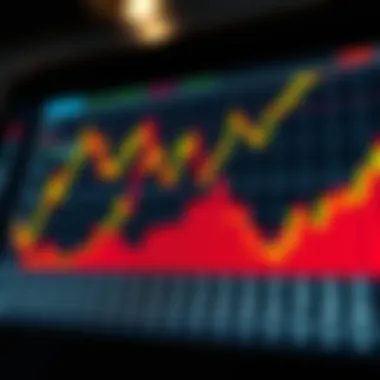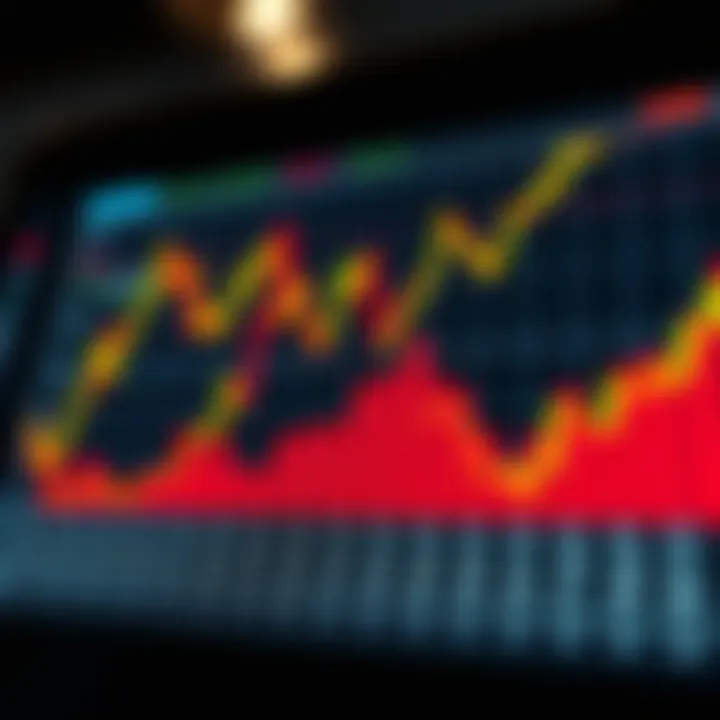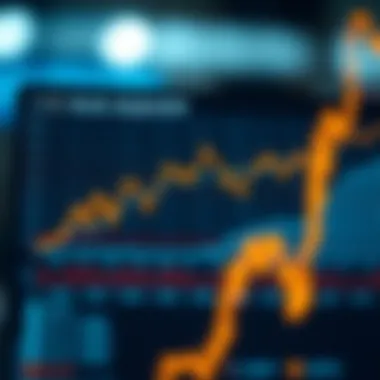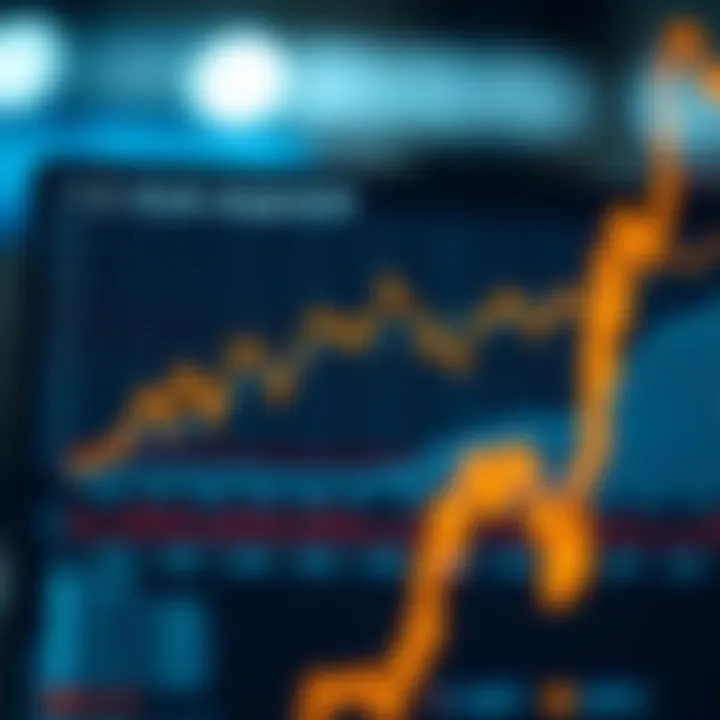Understanding XLB ETF Holdings: A Comprehensive Guide


Intro
In the ever-evolving world of finance, exchange-traded funds (ETFs) have carved out a significant niche. These investment vehicles not only offer exposure to a basket of securities but also present unique advantages such as liquidity, diversification, and cost efficiency. One such ETF gaining attention is the XLB, which focuses on the Materials Select Sector. This guide aims to take a closer look at the intricate components of the XLB ETF, its structure, and role amid various investment strategies.
Understanding the XLB ETF extends beyond just recognizing its popularity. It digs down into the nitty-gritty of its holdings, revealing underlying assets that collectively represent the materials sector. By understanding the makeup of the XLB, one gains insight into sector performance, market trends, and potential investment opportunities.
Key Terms and Concepts
Definition of Key Terms
Before we dive deeper into XLB ETF holdings, it’s crucial to grasp some fundamental terminology:
- ETF (Exchange-Traded Fund): A collection of securities traded on stock exchanges, much like individual stocks.
- Sector Allocation: The distribution of investments across different sectors in an ETF. This affects risk and profitability.
- Underlying Holdings: The specific securities contained within an ETF. In the case of XLB, these are predominantly materials companies.
- Expense Ratio: The annual fee expressed as a percentage of the fund’s average assets, showcasing the cost of managing the ETF.
Importance of Understanding Terminology
Understanding these key terms is not simply academic; it lays the bedrock for informed investment decisions. Without the proper terminology, one might find themselves lost in the intricate details of investment strategies or market analyses. Knowing the lingo demystifies the process, making it less daunting for both novice and seasoned investors.
Investment Strategies
Long-term vs. Short-term Investment
When contemplating investments in the XLB ETF, one must first decide on the investment horizon. Are you looking to ride the waves of market fluctuations over the long haul, or are you chasing quick returns? Long-term investments typically focus on holding securities for several years, allowing time for growth and market recovery. In contrast, short-term investments require attention to market timing and trends, often resulting in rapid buy-sell decisions.
Risk Tolerance and Asset Allocation
Investors need to evaluate their risk tolerance carefully. Some may prefer the security of established companies found in the XLB, while others are willing to tackle the volatility that can accompany materials sectors, like commodities. Understanding how much risk you can handle guides your choices in asset allocation. Balancing positions in the XLB with other ETFs or stocks can provide a safeguard against market downturns.
Ultimately, grasping these concepts and strategies sets the stage for a more nuanced understanding of XLB ETF holdings. With the right knowledge, investors can navigate the complexities of capital markets with greater confidence.
“Knowledge is the new currency in today’s investment landscape.”
In summary, the XLB ETF presents opportunities that extend beyond the surface, waiting for the discerning investor to unravel. The following sections will delve further into the ETF's structure, components, and implications for a diversified portfolio. Those willing to explore further will find a wealth of strategic insights to empower their investment journey.
Prelims to ETFs
Understanding Exchange-Traded Funds (ETFs) forms the backbone of grasping how investment strategies and financial markets operate today. In this world, where every dollar and decision can ripple through portfolios and economies, knowledge about ETFs goes a long way for both novice and seasoned investors.
Defining Exchange-Traded Funds
Exchange-Traded Funds, or ETFs, represent a basket of securities that trades on stock exchanges, much like individual stocks. This means you can buy and sell shares of an ETF throughout the trading day. Think of it as a mutual fund's more nimble cousin—one that doesn't require you to wait until the end of the trading day to determine its value.
ETFs typically track a specific index, commodity, or a mix of assets, offering exposure to many sectors and geographic markets without the need to hand-pick individual stocks. Investors can gain instant diversification; it's as if you're casting a wide net in the vast sea of the stock market. An ETF can consist of equities, bonds, commodities, or even other ETFs, providing flexibility that traditional investing doesn't easily offer.
Historical Context of ETFs
The inception of ETFs in the early 1990s marked a significant turning point in investment history. It was 1993 when the first US-listed ETF, the Standard & Poor's Depositary Receipts (SPDR), hit the market. This innovation came hot on the heels of increasingly complex financial products, applying the principles of indexing and diversification in a way that was previously uncharted.
The rise of technology also played a crucial role in popularizing ETFs. With online trading platforms making it easier to buy shares, these investment vehicles saw significant growth. From a mere $400 million in assets back then, ETFs have escalated to trillions globally, revolutionizing how individuals and institutions approach investing.
In the years that followed, ETFs evolved further, with emerging structures like thematic ETFs and leveraged ETFs, appealing to a wider variety of investment strategies.
"ETFs have democratized investing, making it accessible to anyone with an internet connection."
When evaluating the importance of ETFs in today's financial landscape, it becomes clear they hold a strategic position. Investors benefit from their lower fees, tax efficiency, and trading flexibility, illustrating why understanding ETFs is indispensable for anyone considering a stake in financial markets.
ETFs, with their captivating mix of simplicity and sophistication, have fundamentally changed how individuals perceive investment opportunities. As we delve deeper into specific ETFs, like the XLB ETF, this foundation will provide critical insights that inform our investment decisions.


Overview of XLB ETF
The XLB ETF holds a crucial spot in the landscape of exchange-traded funds, serving as a gateway for investors looking to tap into the materials sector. Understanding this ETF not only broadens the investment horizon but also provides insights into sector dynamics and performance trends.
With its specialized focus, the XLB ETF allows a targeted approach to investing, making it an essential tool for both novice and seasoned investors. What makes it particularly appealing is its inclusion of fundamental materials companies—think of producers of chemicals, metals, and other essential commodities—providing a clear reflection of economic activities and trends.
What is the XLB ETF?
The XLB ETF, formally known as the Select Sector SPDR Fund - Materials, is an exchange-traded fund that primarily focuses on the materials sector of the economy. It tracks the performance of materials companies, ensuring that investors have a blend of both large and small-cap stocks under one umbrella. The idea is pretty straightforward; by bundling these stocks together, investors gain exposure to a sector that is critical in industrial processes and daily consumables.
Investors are keen on including the XLB in their portfolios since it encompasses essential companies like those in the chemical and mining sectors. Each holding within the XLB ETF is determined through a criteria set, which often emphasizes factors like market capitalization and liquidity. Thus, understanding what the XLB ETF is shapes foundational knowledge for anyone considering this investment strategy.
Purpose of the XLB ETF
The primary purpose of the XLB ETF is to provide investors with a simple yet effective way to gain exposure to the materials sector without having to pick individual stocks. This ETF serves several important roles:
- Diversification: By investing in the XLB, individuals can reduce their risk exposure by spreading their investments across multiple companies and sub-sectors within materials.
- Accessibility: The XLB ETF made it easier for everyday investors to engage in this segment of the market without needing extensive research on each company.
- Performance Tracking: It allows investors to track materials sector performance as a whole, which often correlates with broader economic indicators.
In this ever-evolving financial landscape, the XLB ETF provides essential benefits to its investors, allowing them to stay aligned with industry movements and economic developments while potentially reaping significant rewards.
Composition of XLB ETF Holdings
The composition of XLB ETF holdings is a pivotal aspect of understanding how this specific exchange-traded fund operates. Given that the XLB ETF centers around the materials sector, investors must pay close attention to the stocks included within its allocations. Comprehending the underlying assets allows investors to gauge potential risks and market opportunities, providing a more substantial basis for their investment decision-making.
Well-aware investors appreciate that an ETF’s performance largely hinges on its holdings. The XLB ETF, focused on materials, includes companies involved in producing raw materials or basic industrial products. Thus, its holdings can widely influence the fund’s behavior in varying market conditions. Knowing this can help in strategizing buy/sell decisions aligning with broader economic trends.
Sector Allocations
Sector allocations within the XLB ETF reveal how its portfolio is structured concerning the materials industry. This section encapsulates the diverse industries covered under the umbrella of materials, such as chemicals, metals, and mining. A careful mix of these sectors can either bolster resilience in uncertain markets or expose vulnerabilities during economic downturns.
It's notable that the fund may shift allocations based on prevailing market conditions. For example, a bullish outlook on construction might increase investment in companies specializing in aluminum or cement, while a downturn may see a reallocation toward more defensive industries within the sector. This adaptability can be both an asset and a risk, depending on how market dynamics play out. The strategic sector allocation, hence, is not merely numbers on a pie chart; it’s a reflection of ongoing market sentiment and potential growth areas.
Top Holdings Breakdown
The top holdings of the XLB ETF provide direct insight into the fund’s largest components, which often carry significant weight regarding performance. These companies usually exhibit strong fundamentals and market positions that help stabilize the fund’s price action. Familiar names within this ETF might include giants like LyondellBasell Industries and Dow Inc., which play a crucial role in shaping the overall return profile of the ETF.
By analyzing these top holdings, investors can uncover essential insights regarding sector strengths, weaknesses, and trends. For instance, a heavy concentration in one or two specific companies may imply risk. If those companies falter, the entire fund could face ripple effects. Conversely, a well-diversified holding structure can help buffer against volatility, providing sustainability in the long run.
Weighting of Individual Stocks
The weighting of individual stocks in the XLB ETF is a fundamental consideration that affects both return and risk. Typically, ETFs use a market capitalization weighting method, meaning larger companies will have more sway over the ETF’s performance. Some argue that this can be a double-edged sword, given that a top-heavy portfolio can lead to substantial exposure risks during market swings.
To illustrate, if the top holding in the XLB ETF is DuPont de Nemours Inc., and it begins to underperform due to industry challenges, the overall performance of the ETF might falter as a result. Conversely, a strong performance from a lesser-weighted stock could have minimal impact in a market cap-weighted environment.
Investors should consider how individual stock weightings align with their risk appetite and investment horizon. Understanding the balance between potential reward and risk in stock weightings can offer invaluable insights into the fund's behavior under varying market conditions.
"The essence of investing lies in understanding what you own, and the XLB ETF is no different. Its holdngs define not just its price, but also its essence."
Analysis of Performance Metrics
Evaluating the performance of an Exchange-Traded Fund (ETF) like XLB is crucial for investors looking to gauge the effectiveness of their investments. Performance metrics provide clarity on how well the ETF's holdings have fared over time, allowing investors to make informed decisions regarding their financial strategies. Understanding these metrics supports risk management, helps inform timing decisions, and ultimately guides investors in assessing the relative attractiveness of the XLB ETF compared to other investment options.
Historical Performance Overview
Looking at historical performance is like checking the rearview mirror when driving; it gives insights about the path traveled. The XLB ETF, which focuses on the materials sector, typically shows various trends influenced by economic cycles. By evaluating past returns, it becomes possible to determine whether the ETF has consistently delivered value to its shareholders.
Key factors to consider include:
- Annualized Returns: Provides a yearly growth rate, showing how much the ETF has gained over time.
- Volatility: Measures the fluctuation of fund prices, indicating how much risk is involved.
- Maximum Drawdown: Helps investors understand the worst-case scenario by indicating the largest percentage drop from peak to trough.


In essence, historical performance serves as a foundational layer that informs future expectations. It’s not merely about numbers; this data can reflect broader market sentiments and trends, allowing investors to pinpoint patterns or anomalies in the ETF's performance.
Risk Assessment
Understanding risk factors associated with the XLB ETF is key for investors gauging potential pitfalls. Risk assessment entails looking at various elements, such as market fluctuations, liquidity risk, and specific risks tied to the materials sector, like commodity price changes.
A thorough risk analysis incorporates:
- Beta: A measure of the ETF's volatility relative to the overall market. A higher beta suggests a riskier investment.
- Standard Deviation: Reflects how much returns can deviate from the average, giving insights on expected variability.
- Correlation with Market Indices: Understanding how closely the XLB ETF correlates with major indices can influence risk management strategies.
Investors must balance their risk tolerance against potential returns. Often, seasoned investors might take on slightly higher risks hoping for better, long-term gains, while others might prefer a more conservative approach.
Comparison with Benchmark Indices
When assessing the XLB ETF's performance, it's important to compare it with benchmark indices. This provides a contextual understanding of how well the ETF is doing relative to similar investment options.
In particular, comparing the XLB ETF against the S&P 500 or sector-specific indices, like the S&P Materials Select Sector Index, gives a clearer picture. Consider the following:
- Performance vs. Benchmarks: If XLB consistently outperforms benchmarks, that could indicate strong management and favorable asset selection.
- Tracking Error: This metric reveals how closely the ETF follows its benchmark index. A low tracking error signifies that the ETF aims to closely replicate the index performance.
Ultimately, comparisons to benchmark indices are not just about highlighting successes; they spotlight areas where the ETF could improve or adapt. Benchmarking serves as a critical tool, allowing investors to understand if the XLB ETF is worth their hard-earned money or if other avenues may offer better prospects.
Factors Influencing XLB ETF Holdings
Understanding the dynamics behind the holdings of the XLB ETF is fundamental for any investor interested in this particular market segment. Factors such as market trends and economic indicators mold the environment in which the XLB ETF operates. Grasping these elements not only aids in evaluating the fund's performance but also enhances decision-making for prospective investments.
Market Trends Impact
The influence of market trends on the XLB ETF cannot be overstated. Typically, these trends reflect broader financial sentiments. When investors are feeling bullish about the economy, sectors represented within the XLB, like basic materials, tend to garner attention. Conversely, a bearish outlook can lead to pronounced volatility in these sectors. This fluctuation can directly affect the ETF's holdings.
- Seasonal Trends: Certain industries within the materials sector may experience seasonal demand fluctuations. For example, construction materials might see increased demand during warmer months, which affects stock pricing and, hence, XLB’s performance.
- Technological Advancements: The integration of new technologies can create shifts within the industry. For instance, more eco-friendly materials are becoming popular, impacting which companies are favored in the ETF. Investors should keep an eye on innovations that improve efficiency within the basic materials space.
“Trends are like waves; surf the right ones and you might catch a great ride.”
Economic Indicators
Economic indicators are the heartbeat of an economy, and their significance in the assessment of XLB ETF holdings is undeniable. These indicators serve as a compass for investors, providing insights into potential economic climate changes.
- GDP Growth Rate: A rising GDP typically indicates a healthy economy, which often leads to increased consumption of materials. When GDP grows, the demand for XLB holdings usually follows suit, bolstering their value.
- Inflation Rates: Inflation can be a double-edged sword. While moderate inflation may enhance profits for companies in the materials sector due to higher prices, excessive inflation can squeeze margins and affect stock performance negatively.
- Interest Rates: The Federal Reserve's decisions on interest rates can significantly impact investment in basic materials. Lower rates often mean cheaper borrowing costs, fostering investment in infrastructure and construction, which could enhance XLB ETF holdings.
Being acutely aware of these indicators equips investors with the foresight necessary when navigating the complex landscape of ETF holdings. Understanding how macroeconomic factors interplay with specific sectors can inform strategic choices that lead to better portfolio management.
Ultimately, recognizing the significance of market trends and economic indicators in the context of XLB ETF holdings strengthens an investor's capacity to make calculated and informed decisions.
Investor Considerations
When navigating the complex landscape of investing, understanding the considerations surrounding your investment choices becomes crucial. In the realm of ETFs, and specifically the XLB ETF, these considerations can define your long-term success. Investors not only need to scrutinize the holdings but also appreciate how these factors interact to create a holistic investment strategy.
Building a Diversified Portfolio
Building a diversified portfolio is akin to spreading your bets in a high-stakes poker game. You wouldn't put all your chips on one hand; similarly, investing across various asset classes and sectors can mitigate risks significantly.
For an ETF like XLB, which is concentrated in sectors like materials and industrials, adding other assets can balance potential volatilities.
- Why Diversification Matters:
- Reduces impact from poor-performing assets.
- Enhances potential returns across different sectors.
- Provides exposure to various market cycles.
In practice, one might consider combining XLB with broader market ETFs or fixed income options. The idea is to find complementary assets that can help smooth fluctuations in your portfolio's value.


Tax Efficiency of ETFs
Tax efficiency plays a role that often goes unnoticed in investment planning. Because ETFs like XLB typically utilize an in-kind creation and redemption process, they can help investors sidestep capital gains that might haunt traditional mutual funds.
The key benefits of tax efficiency include:
- Minimized Capital Gains Distributions:
- Potential for Tax Loss Harvesting:
- This keeps the taxable event lower than in many mutual fund structures, keeping more in your pocket.
- Investors can realize losses by selling declining assets while maintaining exposure through similar ETFs.
Understanding these benefits can lead to more informed decisions about when to buy or sell, enhancing your overall returns after tax considerations.
Costs and Fees Involved
Every investment comes with costs, and ETFs are no exception. While XLB might have lower expense ratios compared to actively managed funds, paying attention to fees is still vital. Fees can erode returns, often in ways that many beginners overlook.
Consider the following points regarding fees:
- Expense Ratios:
- Trading Commissions:
- Bid-Ask Spreads:
- This fee is annual and calculated as a percentage of your total investments in the ETF. Lower is generally better.
- While many brokers now offer commission-free trades, it's essential to check if your investment platform charges anything.
- The difference between the buying and selling price can impact your cost basis if you trade frequently.
A savvy investor will always assess these costs relative to the expected returns from their XLB ETF investment. The balance between minimizing costs and maximizing potential returns shapes effective investment strategies.
In summary, understanding these investor considerations can significantly enhance your decision-making process, equipping you with tools necessary for a sound investment approach.
By considering how to diversify effectively, optimize tax efficiency, and manage costs, investors can attain improved financial outcomes when engaging with XLB ETF holdings.
Future Outlook for XLB ETF Holdings
The future outlook for XLB ETF holdings brings to light how investors can navigate the changing landscape of this specialized sector. As the trends in material-related industries evolve, so does the potential for the fund's growth or the challenges it faces. Grasping these dynamics is crucial for both seasoned investors and beginners alike, allowing for informed decisions that align with one's financial goals.
Potential Growth Areas
In the realm of the XLB ETF, growth isn't purely about numbers; it often intertwines with broader economic shifts. Here are some areas where investors might find ripe opportunities:
- Sustainable Materials: With the increasing emphasis on sustainability, sectors focusing on environmentally friendly materials are on the rise. Companies innovating in recyclable or bio-based materials are likely to grab market interest.
- Technology Integration: The fusion of technology with the materials sector can't be ignored. Firms leveraging advanced manufacturing techniques or integrating artificial intelligence in their processes could redefine production efficiency and, in turn, profitability for the XLB ETF holdings.
- Infrastructure Spending: As various governments ramp up infrastructure projects, the demand for raw materials will likely surge. Investors might want to keep their eyes peeled for companies benefiting from this trend, as they could become significant players within the XLB.
"Investors should not only look at current performance metrics but also the broader economic contexts that could drive future growth."
Challenges Ahead
However, with potential for growth comes a range of challenges that could impact the XLB ETF holdings. Recognizing these pitfalls early can equip investors with proactive strategies. Consider the following:
- Regulatory Changes: The materials sector often finds itself under the scrutiny of government regulations, particularly with respect to environmental policies. Sudden changes or implementations can disrupt operations and affect stock prices adversely.
- Market Volatility: The materials segment is inherently tied to market dynamics. Economic downturns can lead to reduced demand for materials, resulting in poor performance for the XLB ETF. Investors must assess their risk tolerance amid such volatility.
- Supply Chain Disruptions: Historically, global events such as pandemics or geopolitical tensions have exposed vulnerabilities within supply chains. The materials sector, from procurement to delivery, can face significant hurdles, affecting companies in the XLB ETF.
By staying aware of both potential growth areas and looming challenges, investors can better position themselves in the ever-evolving market associated with XLB ETF holdings.
Culmination
In summation, the discussion surrounding the XLB ETF offerings is not just an account of its numerical components, but a dive into the very soul of what it means to invest in such a fund. By understanding the intricate nature of XLB ETF holdings, investors can better navigate their financial choices and position themselves strategically within the market. This article highlights the structure, essential components, and overall significance of this ETF, paving the way for calculated investment decisions.
Key Takeaways
- Diverse Holdings: The XLB ETF encapsulates a range of holdings within the materials sector, making it an attractive choice for investors seeking exposure to various industries.
- Sector Sensitivity: It’s important to keep in mind the sector's susceptibility to economic shifts and market trends, which can significantly influence performance.
- Investment Strategy: Aligning XLB ETF holdings with one’s investment goals can foster a balanced portfolio, allowing for both growth and stability.
- Monitoring Performance: Continuous evaluation of performance metrics is crucial. Investors should remain aware of how the XLB ETF measures against benchmark indices for a clear picture of its effectiveness.
Final Thoughts
The XLB ETF plays a pivotal role in the landscape of exchange-traded funds, especially for those with a keen interest in materials and industrial sectors. Grasping the multifaceted nature of its holdings provides not only a potential for financial growth but also an understanding of the underlying market dynamics.







